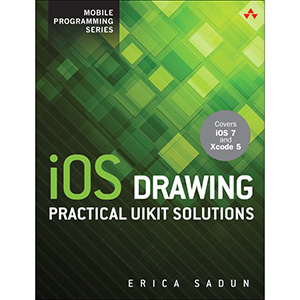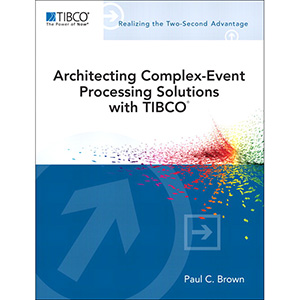Wow! eBook: iOS Components and Frameworks - 4 new eBooks |  |
- iOS Components and Frameworks
- iOS Drawing
- Architecting Complex-Event Processing Solutions with TIBCO
- A Tour of C++
| Posted: 03 Jan 2014 06:02 AM PST
Book DescriptionTake Your Next Leap Forward as an iOS App Developer! Covers iOS 7 and Xcode 5 iOS Components and Frameworks will help you leverage iOS's powerful components and frameworks to build apps with outstanding performance, reliability, interactivity, media support, and customization. Pioneering iOS developers Kyle Richter and Joe Keeley illuminate the sophisticated intermediate-to-advancedlevel techniques you're now ready for. You'll find example-rich coverage of topics ranging from social support to security, Core Data, TextKit, iCloud support, UIKit Dynamics, MapKit, and Passbook. There's also a complete section on advanced performance and security, including the effective use of Grand Central Dispatch and Keychain. Each chapter contains a complete sample project that walks you through integrating its technology into a typical iOS app. You'll discover how multiple iOS features can be combined into exceptionally powerful apps and walk through a complete case study project: a fully functional game with complete Game Center integration. Coverage includes:
If you're a serious iOS developer who wants to build cutting-edge apps, iOS Components and Frameworks delivers the practical skills, reusable code, and expert insights you're looking for. Table of Contents Book Details
Related Books
The post iOS Components and Frameworks appeared first on Wow! eBook. |
| Posted: 03 Jan 2014 05:56 AM PST
Book DescriptionCovers iOS 7 and Xcode 5 Apple lavished iOS with a rich and evolving library of resolution-independent 2D drawing utilities. Its APIs include powerful features such as transparency, path-based drawing, anti-aliasing, and more. Harness these low-level, lightweight drawing routines in your apps to build images, to create PDFs, to display views, and to print. In this guide, Erica Sadun, bestselling author of The Core iOS 6 Developer’s Cookbook and The Advanced iOS 6 Developer’s Cookbook, helps readers explore iOS drawing through an abundance of examples alongside plenty of explanations and tips. This short work provides the basic how-to developers need to get started. You will learn about these specific topics:
To access the code samples, visit https://github.com/erica/iOS-Drawing. Table of Contents Appendix A. Blend Modes Book Details
Related Books
The post iOS Drawing appeared first on Wow! eBook. |
| Architecting Complex-Event Processing Solutions with TIBCO Posted: 03 Jan 2014 05:49 AM PST
Book Description“Complex-event processing is simple in principle but hard to do well in practice. This guide presents the principles and motivations for those new to the subject. More importantly, it details the entire thought-landscape of a complete implementation, using TIBCO products as the background. Well worth the read for anyone who is thinking of implementing a complex-event solution. Those who have already implemented one should read it as well, both for another perspective and for a view of the capabilities of the TIBCO products." "This complete guide drives you through the specifics of complex-event processing (CEP) design concepts. The book covers all the fundamental aspects and design phases relevant for any TIBCO CEP project implementation, from design through performance-tuning and deployment. I would highly recommend this book to any reader interested in CEP concepts, although a small amount of TIBCO technology knowledge will let you appreciate it more." The architecture series from TIBCO® Press comprises a coordinated set of titles for software architects and developers, showing how to combine TIBCO components to design and build real-world solutions. Complex-event processing is required when multiple events occurring throughout an organization must be sensed, analyzed, prioritized, and acted on in real time. Architecting Complex-Event Processing Solutions with TIBCO® shows how to design and architect complex-event processing systems, addressing all their complexities and achieving maximum efficiency and effectiveness, while delivering superior business value. After reading this book, you will be able to
Architecting Complex-Event Processing Solutions with TIBCO® is intended for working architects, designers, and developers who want to apply TIBCO products in complex-event processing applications. It is also required reading for anyone seeking TIBCO Certified Architect status. Table of Contents Part II: Technology Part III: Design Patterns Part IV: Deployment Book Details
Related Books
The post Architecting Complex-Event Processing Solutions with TIBCO appeared first on Wow! eBook. |
| Posted: 03 Jan 2014 05:44 AM PST
Book DescriptionThe C++11 standard allows programmers to express ideas more clearly, simply, and directly, and to write faster, more efficient code. Bjarne Stroustrup, the designer and original implementer of C++, thoroughly covers the details of this language and its use in his definitive reference, The C++ Programming Language, Fourth Edition. In A Tour of C++, Stroustrup excerpts the overview chapters from that complete reference, expanding and enhancing them to give an experienced programmer–in just a few hours–a clear idea of what constitutes modern C++. In this concise, self-contained guide, Stroustrup covers most major language features and the major standard-library components–not, of course, in great depth, but to a level that gives programmers a meaningful overview of the language, some key examples, and practical help in getting started. Stroustrup presents the C++ features in the context of the programming styles they support, such as object-oriented and generic programming. His tour is remarkably comprehensive. Coverage begins with the basics, then ranges widely through more advanced topics, including many that are new in C++11, such as move semantics, uniform initialization, lambda expressions, improved containers, random numbers, and concurrency. The tour ends with a discussion of the design and evolution of C++ and the extensions added for C++11. This guide does not aim to teach you how to program (see Stroustrup's Programming: Principles and Practice Using C++ for that); nor will it be the only resource you'll need for C++ mastery (see Stroustrup's The C++ Programming Language, Fourth Edition, for that). If, however, you are a C or C++ programmer wanting greater familiarity with the current C++ language, or a programmer versed in another language wishing to gain an accurate picture of the nature and benefits of modern C++, you can't find a shorter or simpler introduction than this tour provides. Table of Contents Book Details
Related Books
The post A Tour of C++ appeared first on Wow! eBook. |
| You are subscribed to email updates from Wow! eBook To stop receiving these emails, you may unsubscribe now. | Email delivery powered by Google |
| Google Inc., 20 West Kinzie, Chicago IL USA 60610 | |




Tidak ada komentar:
Posting Komentar